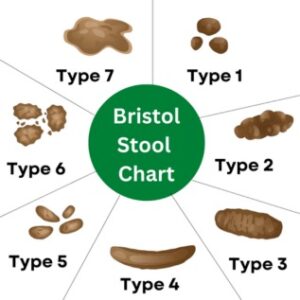
The Bristol Stool Chart Guide: What’s Your Poo Telling You?
When it comes to health, discussing bowel movements isn’t exactly table talk, but it’s a crucial aspect of monitoring your health. The Bristol Stool Chart can provide insight into your digestive health and can guide you toward recognizing potential issues with your colon. This chart isn’t just a topic for medical professionals; it’s useful for everyone to understand what their stool is signaling about their overall health. So in this blog, we’ll go through the Bristol Stool Chart as well as stool colors to give you a better understanding about what your poo is telling you.
What Is the Bristol Stool Chart?
The Bristol Stool Chart categorizes human stool into seven types to indicate the health of the digestive system. By using this visual guide, individuals can determine if their bowel movements are normal or if they need to seek medical help. Here’s what each type means:

- Type 1-2: Hard and lumpy poos, typically hard to pass, indicates constipation.
- Type 3-4: These are the ideal stools; smooth, soft, and easy to pass, suggesting a healthy diet and good hydration.
- Type 5: Soft blobs with clear-cut edges are normal but may signal a lack of dietary fiber.
- Type 6-7: Loose or watery stool, potentially indicating food intolerances or other digestive issues.
Health Insights from Your Stool
- Consistency and Type: By observing the type of stool you most frequently encounter, you can glean insights into your gut health. Types 3 and 4 are generally considered optimal, reflecting balanced digestion and adequate fiber and fluid intake.
- Frequency and Ease: Regular, pain-free bowel movements suggest a healthy digestive tract. Conversely, frequent hard stools or diarrhea could indicate dietary issues or health concerns.
- Changes and Patterns: Sudden changes in your stool type, frequency, or color can signal health issues. Persistent changes warrant professional evaluation and might require adjustments in diet, hydration, or even medical intervention.
Leveraging the Bristol Stool Chart for Better Health
Understanding your stool pattern with the help of the Bristol Stool Chart can be your first line of defense in maintaining colon and overall health. It’s a simple yet effective tool for early detection of potential health issues.
Stool Colors and What They Mean for Your Health
As well as the shape and texture of your poo, the color of your stool can also provide significant insights into your digestive health, ranging from normal variations due to diet to potential underlying health issues.
Here’s a basic guide to what different stool colors might indicate:
- Brown: This is the most common stool color, influenced by bile produced in your liver. Brown stools are typically a sign of a healthy digestive system.
- Green: Green stool can occur when you eat a lot of green vegetables or foods with green coloring. It can also happen if the stool moves too quickly through the intestine and doesn’t have time to change to the usual brown color.
- Yellow: A yellow, greasy, and foul-smelling stool could indicate excess fat, which could be a sign of a malabsorption disorder like celiac disease. Yellow can also show early signs of gallbladder issues.
- Black: Black stool can be caused by iron supplements or certain medications. However, it could also indicate bleeding in the upper gastrointestinal tract, such as from ulcers or gastritis.
- Red: Red stool can indicate bleeding in the lower gastrointestinal tract, such as from hemorrhoids or colorectal cancer. However, if you have red poo, don’t panic. First, consider what you have eaten in the last 24-48 hours before assuming a health issue, as foods with red food coloring or foods like beets can change the color.
- Pale, white, or clay-colored: This may suggest a lack of bile in the stool, possibly due to a bile duct obstruction. Conditions affecting the liver, gallbladder, or pancreas could also cause pale stools. White can also signify drug use, particularly medications that may interfere with bile production.
- Orange: This can happen with foods high in beta-carotene, such as carrots and sweet potatoes, or medications. If orange stool persists without a clear dietary cause, it may suggest issues with bile salts and the liver.
Take Action Based on Stool Color
If you notice a persistent change in stool color, especially if accompanied by other symptoms like pain, weight loss, or changes in appetite, it’s important to seek medical advice. These changes can be an indicator of underlying health issues that need prompt attention.
Conclusion
While it might seem odd to examine your stool, doing so is a proactive measure to maintain your health. The Bristol Stool Chart provides an easy-to-understand framework that can help you identify potential health issues before they become severe. Pay attention to what your body is telling you through your bowel movements—it’s one of the simplest ways to evaluate your health status.
Understanding your stool through the Bristol Stool Chart is more than just a curiosity—it’s a proactive step toward maintaining your overall health. The chart provides clear indications of possible digestive issues and what they might mean for your overall well-being.
Concerned about your digestion and stool health?
Take our free root cause analysis for mind and body health. Let’s get to the root causes of your health issues. We can provide you with a wealth of free personalized information to help you on your health journey. If further investigation is needed, we can advise you about your options. Plus we give you a free 30-minute health strategy session to help you improve your situation.
This detailed analysis will help you understand your body’s signals and what they indicate about your health, allowing you to make informed decisions moving forward. Start your free root cause analysis (RCA) today!
- Complete the RCA Online Now
- Find out more about our root cause analysis, or request the RCA Form via email below to complete at your own convenience.



